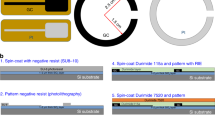Abstract
Thin films of glass are attractive as a means for protecting integrated circuits for use in biological systems and are especially suitable for use with biomedical sensors. They offer advantages over polymer films since they can be deposited in thin, uniform layers and can be photoengraved using conventional techniques. This paper first reviews the requirements for film quality in using thin glassy films in these applications and then reviews the techniques available for film deposition. One technique which has been found especially suitable for biomedical work is described in detail, and the characterization of the resulting films is discussed.
Films of silicon dioxide and silicon nitride 0·2–0·3 μm thick have exhibited adequate adhesion and continuity for use with sensors fabricated using integrated circuit technology. Furthermore, they have provided excellent corrosion protection for unencapsulated transistors implanted in the brain for periods of 4 months. Such glassy films also provide good electrical insulation for applied voltages less than 1 V; however, when higher voltages are present, thicker films are required to avoid excessive leakage currents. Applications to specific sensors are considered.
Sommaire
Les pellicules de verre minces sont intéressantes comme moyens de protection de cricuits intégrés employés dans les systèmes biologiques et sont particulièrement appropriés à l'emploi avec les senseurs biomédicaux. Ils offrent des avantages par rapport aux pellicules polymériques car ils peuvent être déposés sous forme de couches minces, uniformes et peuvent être photogravées de façon classique. Cet article passe d'abord en revue les qualités de pellicule nécessaires à des pellicules de verre dans ces applications, puis les techniques disponibles pour la déposition de pellicule. On décrit en détail une technique qui a été trouvée être particulièrement appropriée au travail biomédical et l'on discute la caractérisation des pellicules qui en résultent.
Des pellicules de bioxyde de silicium et de nitrure de silicium de 0,2 à 0,3 μm d'épaisseur ont montré une adhésion et une continuité adéquates pour l'emploi avec des senseurs fabriqués par la technologie de circuits intégrés. De plus ils ont offert une excellente protection contre la corrosion de transistors non-encapsulées implantés dans le cerveau pendant des périodes de 4 mois. De telles pellicules de verre offrent également une bonne isolation électrique pour des tensions appliquées inférieures à 1 V; cependant pour des tensions plus élevées, des pellicules plus épaisses sont nécessaires pour éviter des courants de fuite excessifs. On considère des applications à des senseurs spécifiques.
Zusammenfassung
Dünne Glassfilme besitzen als Mittel zum Schutz integrierter Schaltungen in biologischen Systemen eine Anziehungskraft und sind für Gebrauch mit biomedizinischen Messfühlern besonders geeignet. Sie bieten gegenüber Polymerfilmen Vorteile, da sie in dünnen, gleichmässigen Schichten abgelegt und üblichen Verfahren im Klischee hergestellt werden können. Dieser Bericht behandelt zunächst die Bedingungen der Filmeigenschaft im Gebrauch von dünnen Glassfilmen für diese Anwendungszwecke und behandelt dann die erhältlichen Verfahren für Filmlagerung. Eine Technik, welche für biomedizinische Arbeit besonders geignet gefunden wurde, wird in Einzelheiten beschrieben und die Charakterisierung der sich ergebenden Filme wird besprochen. Filme aus Siliziumdioxyd und 0,2–0,3 μm dicken Siliziumnitrid haben austeichende Adhäsion gezeigt und Beständigkeit für Gebrauch mit Messfühlern, welche mit integrierter Schaltungstechnologie hergestellt waren.
Darüberhinaus haben sie ausgezeichneten Korrosionsschutz für ungekapselte, ins Gehirn gepflanzte Transistoren für Dauern von 4 Monaten geboten. Diese Glassfilme geben auch gute elektrische Isolation für verwendete Spannungen von weniger als 1 V. Wenn allerdings hönere Spannungen vorhanden sind, werden dickere Filme benötigt, um übermässige Streuströme zu vermeiden. Es werden Verwendungszwecke für spezifische Messfühler in Betracht gezogen.
Similar content being viewed by others
References
Braley, S. (1968) The silicones as subdermal engineering materials.Ann. N.Y. Acad. Sci. 146, 148–157.
Burger, R. M. andDonovan, R. P. (1967) In:Fundamentals of Silicon Integrated Device Technology, Vol. 1. Prentice-Hall, Englewood Cliffs, New Jersey.
Cunningham, J. A. (1965) Expanded contacts and interconnections to monolithic silicon integrated circuits.Solid-St. Electron. 8, 735–745.
Eisenman, G. (1962) Cation selective glass electrodes and their mode of operation.Biophys. J. 2, 259–311.
Frank, K. andBecker, M. C. (1964) Microelectrodes for recording and stimulation. In:Physical Techniques in Biological Research, Vol. 5. (Ed.W. L. Nastuk) Chapter 2. Academic Press, New York.
Frank, R. K. andMoberg, W. L. (1970) Reactively sputtered silicon oxynitride as a dielectric material for metal-insulator-metal capacitors.J. Electrochem. Soc. 117, 524–529.
Halpern, B. D. (1968). Polymers in medicine and surgery—a survey.Ann. N.Y. Acad. Sci. 146, 193–201
Joyce, R. J., Sterling, H. F. andAlexander, J. H. (1967–8) Silicon oxide and nitride films deposited by an r.f. glow-discharge.Thin Solid Films 1, 481–494.
Kern, W. andHeim, R. C. (1970). Chemical vapor deposition of silicate glasses for use with silicon devices.J. electrochem Soc. 117, 562–573.
Kittel, C. (1956).Introduction to Solid-State Physics, 2nd Edn, p. 163. Wiley, New York.
Levine, S. N. (1968). Survey of biomedical materials and some relevant problems.Ann. N.Y. Acad. Sci. 146, 3–10.
Moore, E. W. (1968). Cation measurements in biological materials.Ann. N.Y. Acad. Sci. 148, 93–109.
Pliskin, W. A. andLehmen, H. S. (1965) Structural evaluation of silicon oxide films.J. electrochem. Soc. 112, 1013–1019.
Robb, W. L. (1968) Thin silicone membranes—their permeation properties and some applications.Ann. N.Y. Acad. Sci. 146, 119–137.
Schneer, G. H., Van Gelder, W., Hauser, V. E. andSchmidt, P. F. (1968) A metal-insulator-silicon junction seal.IEEE Trans. Electron. Dev. ED-15, 290–293.
Swann, R. C. G., Mehta, R. R. andCauge, T. P. (1967) The preparation and properties of thin film siliconnitrogen compounds produced by a radio frequency glow discharge reaction.J. electrochem. Soc. 114, 713–717.
Sze, S. M. (1967) Current transport and maximum dielectric strength of silicon nitride films.J. appl. Phys. 38, 2951.
Tufte, O. N., Chapman, P. W. andLong, D. (1962). Silicon diffused-element piezoresistive diaphragms.J. appl. Phys. 33, 3322–3327.
Warner, R. M. andFordemwalt, Eds. (1965)Integrated Circuits—Design Principles and Fabrication. McGraw-Hill New York.
White, M. L. (1969) Encapsulation of integrated circuits.Proc. IEEE 57, 1610–1615.
Wise, K. D., Angell, J. B. andStarr, A. (1970) An integrated-circuit approach to extracellular microelectrodes.IEEE Trans. Biomed. Engng BME-17, 238–247.
York, D. B. (1963) Properties of evaporated thin films of SiO.J. electrochem. Soc. 110, 271–275.
Author information
Authors and Affiliations
Rights and permissions
About this article
Cite this article
Wise, K.D., Weissman, R.H. Thin films of glass and their application to biomedical sensors. Med. & biol. Engng. 9, 339–350 (1971). https://doi.org/10.1007/BF02474087
Received:
Issue Date:
DOI: https://doi.org/10.1007/BF02474087




